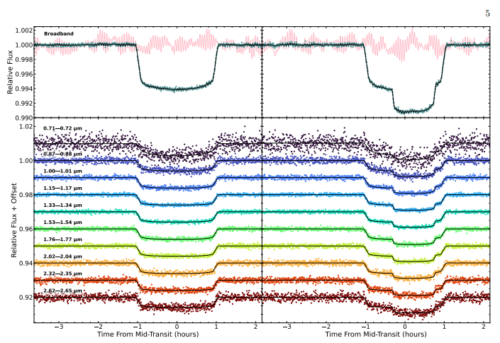2024-07-08 ミシガン大学
<関連情報>
- https://news.umich.edu/astronomers-find-surprising-ice-world-in-the-habitable-zone-with-jwst-data/
- https://arxiv.org/abs/2406.15136
JWST/NIRISSによるハビタブルゾーン太陽系外惑星LHS 1140 bの透過分光観測 Transmission Spectroscopy of the Habitable Zone Exoplanet LHS 1140 b with JWST/NIRISS
Charles Cadieux, René Doyon, Ryan J. MacDonald, Martin Turbet, Étienne Artigau, Olivia Lim, Michael Radica, Thomas J. Fauchez, Salma Salhi, Lisa Dang, Loïc Albert, Louis-Philippe Coulombe, Nicolas B. Cowan, David Lafrenière, Alexandrine L’Heureux, Caroline Piaulet, Björn Benneke, Ryan Cloutier, Benjamin Charnay, Neil J. Cook, Marylou Fournier-Tondreau, Mykhaylo Plotnykov, Diana Valencia
arXiv Submitted on 21 Jun 2024
DOI:https://doi.org/10.48550/arXiv.2406.15136

Abstract
LHS 1140 b is the second-closest temperate transiting planet to the Earth with an equilibrium temperature low enough to support surface liquid water. At 1.730±0.025 R⊕, LHS 1140 b falls within the radius valley separating H2-rich mini-Neptunes from rocky super-Earths. Recent mass and radius revisions indicate a bulk density significantly lower than expected for an Earth-like rocky interior, suggesting that LHS 1140 b could either be a mini-Neptune with a small envelope of hydrogen (∼0.1% by mass) or a water world (9–19% water by mass). Atmospheric characterization through transmission spectroscopy can readily discern between these two scenarios. Here, we present two JWST/NIRISS transit observations of LHS 1140 b, one of which captures a serendipitous transit of LHS 1140 c. The combined transmission spectrum of LHS 1140 b shows a telltale spectral signature of unocculted faculae (5.8 σ), covering ∼20% of the visible stellar surface. Besides faculae, our spectral retrieval analysis reveals tentative evidence of residual spectral features, best-fit by Rayleigh scattering from an N2-dominated atmosphere (2.3 σ), irrespective of the consideration of atmospheric hazes. We also show through Global Climate Models (GCM) that H2-rich atmospheres of various compositions (100×, 300×, 1000×solar metallicity) are ruled out to >10 σ. The GCM calculations predict that water clouds form below the transit photosphere, limiting their impact on transmission data. Our observations suggest that LHS 1140 b is either airless or, more likely, surrounded by an atmosphere with a high mean molecular weight. Our tentative evidence of an N2-rich atmosphere provides strong motivation for future transmission spectroscopy observations of LHS 1140 b.



